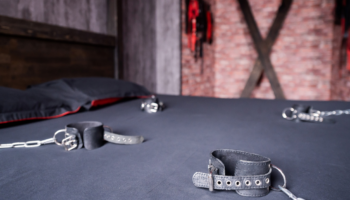Sexual wellness is a fundamental human right, yet people with disabilities or special needs often face barriers in accessing pleasurable experiences. This comprehensive guide explores how vibrators can be adapted for various physical, sensory, and cognitive needs, ensuring everyone can enjoy sexual fulfillment safely and comfortably.
Understanding Special Needs in Sexual Wellness
Approximately 15% of the global population lives with some form of disability (World Health Organization, 2023), yet the sex toy industry has been slow to address their unique requirements. Special needs in sexual wellness may include:
-
Mobility limitations (arthritis, paralysis, limited dexterity)
-
Sensory sensitivities (autism spectrum, neuropathy)
-
Cognitive differences (dementia, traumatic brain injury)
-
Chronic pain conditions (endometriosis, fibromyalgia)
-
Post-surgical considerations (hysterectomy, prostatectomy)
A 2022 study in the Journal of Sexual Medicine found that 68% of adults with physical disabilities reported dissatisfaction with conventional sex toys, highlighting the urgent need for better adaptive options.
Adaptive Vibrator Features for Different Needs
1. For Limited Mobility or Dexterity
Recommended Solutions:
-
Hands-free vibrators like the Dame Eva or We-Vibe Sync that stay in place during use
-
Large-button controls with raised tactile indicators
-
Voice-activated or app-controlled devices such as the Lovense range
-
Extended handles for those with limited reach (e.g., the Suki vibrator with 12″ handle)
Occupational therapist Dr. Sarah Mitchell notes: “Patients with arthritis or limited hand function benefit tremendously from ergonomic designs that minimize grip strength requirements.”
2. For Sensory Sensitivities
*Recommended Solutions:
-
Variable intensity controls with gradual ramping (try the Je Joue Mimi Soft)
-
Non-vibratory options like the Zumio’s rotating tip
-
Hypoallergenic materials (medical-grade silicone, stainless steel)
-
Adjustable patterns to avoid overstimulation
Autistic advocate Jamie Knight explains: “Many neurodivergent individuals need precise control over sensory input. Vibration patterns that can be micro-adjusted make all the difference.”
Specialized Solutions for Specific Conditions
Post-Cancer Rehabilitation
The American Cancer Society reports that 43% of cancer survivors experience sexual dysfunction post-treatment. Specially designed vibrators like the Vita from Dame Products help with:
-
Pelvic floor rehabilitation
-
Restoring blood flow after radiation
-
Gentle stimulation for sensitive post-surgical tissue
For Chronic Pain Sufferers
A 2023 clinical trial at Johns Hopkins demonstrated that controlled vibratory stimulation reduced pain perception in 61% of fibromyalgia patients. Recommended approaches include:
-
Low-frequency, rumbly vibrations (under 50Hz)
-
External-only options for those with vulvodynia
-
Warm-up modes to increase blood flow gradually
Cognitive Considerations
For users with dementia or cognitive impairments, safety-focused designs are crucial:
-
Simple one-button operation
-
Automatic shut-off features
-
Non-threatening shapes and colors
-
Easy-clean surfaces to maintain hygiene
Memory care specialist Dr. Elena Petrov recommends: “Familiar-looking devices that resemble massagers often work best for older adults with cognitive decline.”
Making Existing Vibrators More Accessible
Not everyone can purchase specialized equipment. Try these DIY adaptations:
-
Use velcro straps to secure standard vibrators
-
Attach foam grips to improve hold
-
Mount wand vibrators on adjustable arms
-
Pair with smartphone apps for remote control
Sex therapist Rachel Wright suggests: “Sometimes simple modifications like adding a pillow for positioning or using a mirror for better visibility can dramatically improve accessibility.”
The Future of Inclusive Sex Tech
Emerging innovations promise greater accessibility:
-
Haptic feedback systems for the visually impaired
-
Brainwave-responsive stimulation
-
Temperature-adjustable materials
-
AI-powered pressure sensors
Industry analyst Mark Liu predicts: “Within five years, we’ll see mainstream adoption of universally designed pleasure products that automatically adapt to users’ abilities.”
Key Considerations When Selecting an Adaptive Vibrator
-
Consult your healthcare provider – Especially important for those with spinal injuries or circulatory conditions
-
Prioritize body-safe materials – Look for non-porous, phthalate-free options
-
Test controls before purchase – Many retailers now offer demo units
-
Consider noise levels – Important for those in shared living situations
-
Check return policies – Some companies like Liberator offer adaptive trial programs
Breaking Down Barriers to Pleasure
Despite progress, significant challenges remain. A 2023 survey by the Disability Rights Education & Defense Fund found:
-
72% of adults with disabilities feel excluded by sexual wellness marketing
-
Only 14% of sex toy retailers offer true accessibility features
-
Insurance coverage for therapeutic devices remains inconsistent
Activist and wheelchair user Mia Mingus argues: “Sexual autonomy is a disability justice issue. We need more companies designing with – not just for – disabled communities.”
Getting Started: Your Action Plan
-
Assess your specific needs – Make a list of must-have features
-
Set a realistic budget – Adaptive tech often costs more but lasts longer
-
Try before you buy – Visit an inclusive adult store if possible
-
Be patient with yourself – Exploration may take time
-
Join online communities – Share experiences with others facing similar challenges

